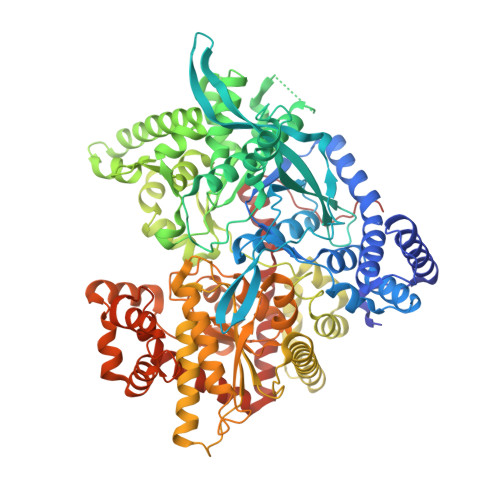Glucopyranosylidene-spiro-imidazolinones, a New Ring System: Synthesis and Evaluation as Glycogen Phosphorylase Inhibitors by Enzyme Kinetics and X-ray Crystallography.
Szabo, K.E., Kyriakis, E., Psarra, A.G., Karra, A.G., Sipos, A., Docsa, T., Stravodimos, G.A., Katsidou, E., Skamnaki, V.T., Liggri, P.G.V., Zographos, S.E., Mandi, A., Kiraly, S.B., Kurtan, T., Leonidas, D.D., Somsak, L.(2019) J Med Chem 62: 6116-6136
- PubMed: 31251604
- DOI: https://doi.org/10.1021/acs.jmedchem.9b00356
- Primary Citation of Related Structures:
6QA6, 6QA7, 6QA8 - PubMed Abstract:
Epimeric series of aryl-substituted glucopyranosylidene-spiro-imidazolinones, an unprecedented new ring system, were synthesized from the corresponding Schiff bases of O -perbenzoylated (gluculopyranosylamine)onamides by intramolecular ring closure of the aldimine moieties with the carboxamide group elicited by N -bromosuccinimide in pyridine. Test compounds were obtained by Zemplén O -debenzoylation. Stereochemistry and ring tautomers of the new compounds were investigated by NMR, time-dependent density functional theory (TDDFT)-electronic circular dichroism, and DFT-NMR methods. Kinetic studies with rabbit muscle and human liver glycogen phosphorylases showed that the ( R )-imidazolinones were 14-216 times more potent than the ( S ) epimers. The 2-naphthyl-substituted ( R )-imidazolinone was the best inhibitor of the human enzyme ( K i 1.7 μM) and also acted on HepG2 cells (IC 50 177 μM). X-ray crystallography revealed that only the ( R ) epimers bound in the crystal. Their inhibitory efficacy is based on the hydrogen-bonding interactions of the carbonyl oxygen and the NH of the imidazolinone ring.
Organizational Affiliation:
Department of Organic Chemistry , University of Debrecen , P.O. Box 400, H-4002 Debrecen , Hungary.





















